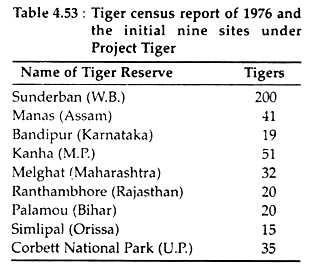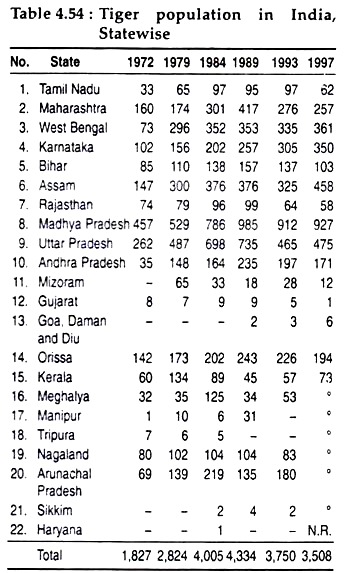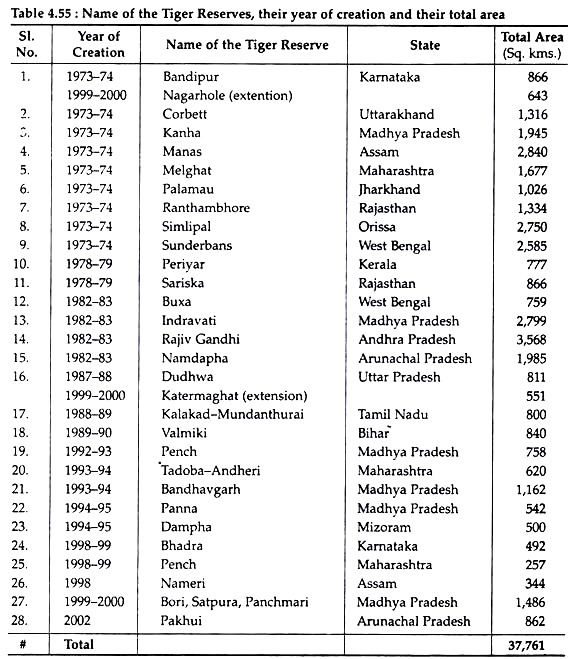In this article we will discuss about:- 1. Introduction to Project Tiger 2. Objectives of Project Tiger 3. Conservation Process 4. Greatest Tragedy 5. Tiger Conservation in West Bengal.
Introduction to Project Tiger:
Tiger (Panthera tigris) has been the integral part to the life and legend of mankind. The tiger has been feared and revered, hunted and worshiped; it has found its way into folklore and lullabies, books of worship, popular fiction and innumerable stories of heroism, bravery and adventure.
At present the tiger is an endangered species and has found its way in the Red Data Book. The tiger population has been reduced from 40,000 to 1,827 by 1972, mainly due to hunting, habitat loss due to deforestation and taming the rivers for human needs.
Considering the fast decline of the tiger population, a special task force was set up in 1970 by the Indian Board for Wildlife to prepare an action plan to conserve the population of tiger in the country. As a result, in 1st April, 1973, Project Tiger was launched.
Objectives of Project Tiger:
ADVERTISEMENTS:
1. To ensure maintenance of a viable population of tigers in India for scientific, economic, aesthetic, cultural and ecological values.
2. To preserve, for all times, areas of biological importance as a national heritage for the benefit, education and enjoyment of the people.
Principles of Tiger Reserves:
In 1973-74 nine tiger reserves were established — located in 9 different states and covering a total area of 13,017 sq. kms.
ADVERTISEMENTS:
It was based on the following principles:
1. Elimination of all forms of human exploitation and disturbance from the core and rationalisation of such activities in the buffer.
2. Limitation of habitat management to repair damage done by man with the aim of restoring the ecosystem as close to its natural functioning as possible.
3. Researching facts about habitat and wild animals and carefully monitoring changes in flora and fauna.
Conservation Process in Project Tiger:
ADVERTISEMENTS:
Conservation of tiger (or any other wildlife) requires the following knowledge:
1. The natural habitat of tiger and its food habit.
2. About the breeding habit and breeding season of tigers.
3. Its relation with other animals.
4. The number of animals present at any given time; reasons for their diminishing or increasing.
5. Places of drinking water and its arrangement.
6. Places of cover and shelter for tigers.
7. Enactment of the laws for their protection.
Levels of Conservation:
ADVERTISEMENTS:
Conservation of tiger is done at the following levels:
Level I:
The population of the tigers in any reserve is to be determined from time to time. The reasons for either their increase or decrease are to be noted. In case of decrease, the reasons are to be located and appropriate measures are to be undertaken.
If they encounter severe diseases then it should be diagnosed and immediate treatments are to be made. If the decrease in number is due to poaching then constant vigilance is to be maintained to keep poachers away.
Level II:
The food of tiger comprises of deer, sambar, wild boar etc. as it is a carnivore. Care should be taken to keep the food animals in sufficient numbers, so that the tiger need not come out of the forest for food and get killed by the hunters.
Level III:
It is essential to have knowledge about the breeding season of the tigers and the number of litters born. The litters should be protected from all sorts of danger including diseases. The diseased litters or tigers should be imprisoned and treated and later released into their natural habitat.
Tiger conservation initiatives and success:
The first official estimation of the Indian tiger population was done in 1972. About 1,827 tigers were recorded in the wild. This led to the setting up of a task force under IBWL which ultimately led to the launching of ‘Project Tiger’ in 1973, beginning with nine sites in nine different states (Table 4.53):
The 1989 census showed that the number of tigers had increased to 4,334, both in the tiger reserves and other areas of wildlife (Table 4.54). The highest (269) number of tigers was reported from Sunderbans, followed by Kanha (97), Nagarjunsagar (97), Simlipal (93) and Manas (92).
However, some alarming decline of tiger population was noted from some tiger reserves like Kanha, Manas. Sariska National Park etc. and in the two north-eastern states of Meghalaya and Arunachal Pradesh (which are outside the tiger reserves).
By 1993 the number of Tiger Reserves had increased to 19 with the census reading (Table 4.54) estimating a total of 3,750 tigers out of which the Tiger Reserve population was 1,266 tigers. M.P. recorded the highest population of 912 tigers, which incidentally was the highest density of tigers anywhere in the world. In 1993 the second phase of Project Tiger was launched to refocus, restructure and reformulate strategies, so as to save not only the tiger and its habitat but also to conserve the entire biodiversity.
The guidelines introduced were:
1. To establish guidelines for tourism in the tiger reserves.
2. To provide management of buffer areas so as to ensure availability of adequate firewood and fodder for the people living on the outskirts of the reserves.
3. To integrate local population through ecological development programmes.
4. To establish Nature Interpretation Centres.
At present the Tiger Reserve has increased to 27, distributed throughout the country and covering a forest area of over 37,700 sq. kms (Table 4.55). The new census of the Tiger population is currently being undertaken.
Project Tiger represents the country’s commitment to protecting wildlife and is recognised today as a conservation success story. Under the chairmanship of the Prime Minister, a steering committee provides guidelines to the management of the tiger reserves. Such projects have ensured the protection of the entire ecosystems, which have resulted over the years to an increase in the tiger population to more than double.
Greatest Tragedy in Project Tiger:
The Tiger Conservation Project has hit the greatest tragedy when the Namdapha tiger reserve in Arunachal Pradesh and Sariska in Rajasthan have been swept clean of the majestic beast. The last census (2001-02) had declared 22 tigers at Sariska and 61 at Namdapha.
Officials of the wildlife department in Namdapha are doubting the presence of only a single big cat in the vast reserve spread across 1,985 square kilometers. But even that one tiger that Namdapha now lays claim has not been sighted by forest officials.
The officials are blaming the poor infrastructure and limited frontline staff, where each staff has to cover an area of 65-70 square kilometers. Another reason which has been sighted to the tragedy is the presence of the Lisu tribe who have settled (originally from Myanmar) in the reserve and are the ones who hunt the beasts.
Tiger Conservation in West Bengal:
Currently there are two cites of ‘Project Tiger’ in West Bengal – Sunderbans and Buxa.
Sundarbans:
Sunderbans is considered as the largest pro-grading delta of the world, consisting of small islands traversed by a network of rivers, canals and creeks. Situated far south of West Bengal, Sundarbans have been formed by the Ganga-Brahmaputra river systems. The major portion of Sunderbans lies in Bangladesh.
The Indian part covers 9,630 sq. kms. of which Project Tiger covers 2,585 sq. kms. The core area (National Park) comprises 1,692 sq. kms. It has been declared as “World Heritage Site”. The unique mangrove ecosystem contains characteristic mangrove vegetation such as Sundri, Garan, Hetal, Keya etc.
The islands hold the largest single population of tigers and also other animal species like deer, monkeys, various types of poisonous snakes, etc. In the canals and rivers the salt water crocodiles thrive. India and Bangladesh have drawn up strategies to work jointly for the cause of tigers and this could lead to more focused attention of the world.
Buxa:
Buxa is situated in the Dooars in North Bengal and is the critical corridor with Assam and Bhutan. The tiger population here had touched a critical low due to poaching. However, Buxa has re-established its pristine status through habitat improvement measures such as canopy opening, plantation of palatable grasses and fodder species, ground water management, fire protection etc. Efforts also have been made to reintroduce the extinct faunal species.
The success of the Project Tiger has shown that, no species, irrespective of its importance, can be conserved in isolation. The residents of Sunderbans and Buxa are aware that the protection of tigers would only serve their own interest. Moreover, they are aware that the investment under the India Eco-development Project is because of its unique tiger habitat.
The Government of West Bengal has whole-heartedly taken up the cause for the conservation and protection of the Royal Bengal Tiger and its habitat as part of its commitment to renew and protect the state’s glorious heritage.


